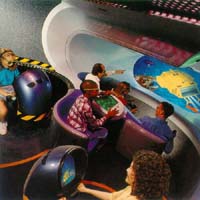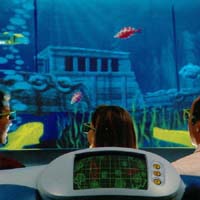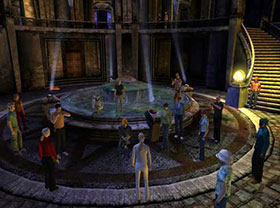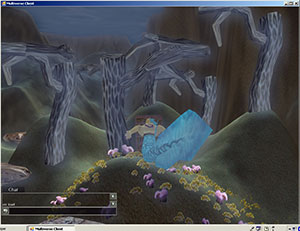The first time we heard Celia Pearce speak, we were fascinated. She was talking about this group of people that was playing Uru Live and moved to other online games after Uru was shut down. Her attention for how people experience games contrasted severely with the usual rhetoric about systems and concepts that comes from most other researchers.
Celia Pearce is currently putting together Indiecade, a presentation of indepent games at E3. Simultaneously, she’s working on an underwater MMO called Mermaids. It’s not her first game, as we learn in this interview. And not her first game that takes place underwater, either. And when she starts talking, she is something of a waterfall herself. Let’s listen…
From accidental designer to reluctant theorist
Tale of Tales (ToT): We have had the pleasure of seeing you speak on several games conferences. Each time we were delighted by your uncommon and yet so recognizable reports of the research you were doing. Where is all this coming from? Could you tell us a bit more about your background?
Celia Pearce (CP): It was never my intention to become a game designer. It was sort of an accident. I moved to New York in 1983 to take a job as a writer for a company I “thought” was designing museum exhibits, Edwin Schlossberg Inc. It turned out that they were actually hiring me to work on this “secret” project which was a nightclub comprised of interactive multiplayer games. In fact, if I knew what I was getting myself into, I may not have taken the job. I really had no experience with video games, except playing Pong and Death Race 2000, which I loved. I remember I was told to go to a meeting and I walked into this room and it was filled from ceiling to floor with sketches of game concepts. And I just stood there with my jaw dropping. But my passion for games was instantaneous, and especially for the multiplayer aspect. I really loved board games as a kid so I drew a lot of that into what we were doing. And anyway, I took to it immediately. Initially I wrote game descriptions, then I did logic flow diagrams, then I initiated a playtesting program, and eventually was promoted to producer/project manager. So even though it was never my intention to be a game designer, I was thrown into it by fate, and it stuck. I consider myself very fortunate in that respect.
ToT: Are there any games or concepts from that era that you are particularly proud of?
“Theme Park design is a really good place for game designers to look for clues as to how to expand their audiences.”

VR Theme Park attraction,
“Virtual Adventures: The Loch Ness Expedition”
CP: The most important I think and probably the most influential was “Virtual Adventures,” which was developed in 1993. It got a lot of critical acclaim, was featured in an interactive theater format at SIGGRAPH 1994, won Best of Show at IAPPA (the theme park expo) and best VR in the Academy of Interactive Arts and Sciences annual award in 1994 or ’95 (Can’t quite recall the year.) This project was a real team effort, and it was my first experience with real-time VR/3D. Because of my background with designing physical installations, it was a good fit for me. But also we had such a stellar team and the end result was excellent on every level. It was also a really new idea, probably the first major VR attraction that was not violent or combat-based. It was also, at that point, the largest networked VR attraction to-date, at 24 players, so I guess you could call it “massively multiplayer” for that era. The game was short, only 4 minutes or so, and revolved around an underwater theme where you were saving the Loch Ness Monster’s Eggs from “bounty hunters,” actually other players. To make the game more challenging, we added a feature where your ship looked like a good guy ship to you but a bad guy ship to everyone else by just flipping the textures around. There were four pods with six players each, so also highly collaborative, and very rare at that point for a networked game to be team-based in this way. BattleTech, which preceded it, had 16 players who were basically competing against each other, each in “his” own pod, and I say “his” because it was very rare to see a woman playing that game. So the other innovation here, which is in part why Iwerks and Evans & Sutherland picked me to design the game, was that it was female-friendly. Even the interface scheme was designed with moms in mind.
“We don’t have time for all this elaborate tutorial nonsense that goes on in most games.”

VR Theme Park attraction,
“Virtual Adventures: The Loch Ness Expedition”
Theme Park design is a really good place for game designers to look for clues as to how to expand their audiences. We have a very different ethos. First of all, we are dealing with a broad audience, ranging from little kids, to grandparents, not all of whom are going to be native English speakers. Second, from a marketing perspective, the structure is totally different from the video game industry: theme park operators are very aware that while the AUDIENCE for their product includes all these different demographics, the BUYER, that is the person who makes the entertainment DECISION is going to be the female head of household. And she is going to make that decision not based on what SHE wants, but on behalf of the entire family; so she is going to want something that she can SHARE with her family and have a good time, and which everyone will enjoy. So one of the goals of the game was to create an experience that promoted family bonding. Third, the format is short, but intense. Players have to be able to learn the game within 30 seconds, so we don’t have time for all this elaborate tutorial nonsense that goes on in most games. The game has to be very dense in its content, to promote repeat play, because that’s really where we make our money. So you can see already the design constraints are quite a bit different. And one of the challenges is that you have to make a game that can be fun for a very broad range of player types, something about which the video game industry as we know it seems pretty clueless for the most part.
ToT: So how did you end up in research?
CP: The transition to a games researcher was somewhat gradual. After moving back to L.A. in 1993 to work on a virtual reality game for Iwerks Entertainment, I began to receive invitations to write and teach. My first few papers were by invitation. I taught in a few venues, AFI, UCLA Extension, Multimedia Studies Program in San Francisco, as well as doing Master Classes in Europe. I sort of describe it as an “invasion of the body snatchers” where I slowly morphed into an academic. After working full-time at universities for a couple of years, I was invited to apply to a Ph.D. program, so I did that while working full time.
CP: It’s actually been very frustrating to me because I think of myself as a designer first and foremost, but in my academic persona, most people know me primarily as a writer/theorist. But my entire perspective arises from my practical experience, so even my theoretical work is very grounded in problems of game design. This is changing now since joining Georgia Tech as I am back in the business of making games.
“I’ve been around long enough to remember when the commercial game industry was much more vibrant and interesting.”
Now I kind of wear two hats: artist/developer and researcher. I’ve also been curating for a long time, so Indiecade is a natural extension of that. I’ve curated or co-curated about four exhibitions and showcases of interactive media, including a game festival. This is something I really value because I’ve been around long enough to remember when the commercial game industry was much more vibrant and interesting. Back when a top-selling CD-ROM sold 100,000-200,000 copies and the average budget was $200K, it was much easier to try new things. Publishers took a lot more risks, and developers were a lot more daring. The advent of the blockbuster I think has been the death knell of creativity in the game industry.
Indie games and creativity
ToT: Is this why you are so interested in independent games at the moment?
“The advent of the blockbuster has been the death knell of creativity in the game industry.”
CP: I want to see more people like you guys get out there and have their work seen.
CP: Part of it is nostalgia for those old days when everything was innovative, and even if it failed, it was still interesting because new things were tried all the time. Once you have genres that marketing folks can see on a shelf in Walmart, then that innovation sort of goes away. So I’m interested in indie games for a couple of reasons. One is I want to see those new genre-creating or genre-bending games, and they are coming occasionally from industry, but few and far between. It’s more really about wanting to promote innovation, and I do that in a number of ways: through teaching, my lab research (which is primarily game-creation), and through my work with indie game developers. So for instance I recently produced this conference at Georgia Tech, Living Game Worlds III: Playing with Reality looking at “documentary games,” loosely construed as games dealing with real-world topics. Activist games are also a big part of my interest and I’m currently working on an Activist Big Game (ActionQuest) with the Design Studio for Social Intervention where people go on quests that entail doing real world social activism as part of the game mechanic. At Living Game Worlds, Tracy Fullerton had this great quote; she said “The Mechanic is the Message,” so we thought, well instead of making a game that is a metaphor for activism, let’s make a game that IS activism.
Designers vs players
ToT: What brings you to gaming as an object of study?
CP: Although I think games are in my blood at this point, part of why I think it is important to study them is because I believe they are the most important medium of this Century. I’m not too original in saying that. But I think for those who had any doubts, it is now clear that video games are here to stay, and that they have infiltrated our culture at every level. I also am perhaps a bit idealistic in that I think interactivity in general represents a positive progression in media because it promotes active participation. I’m especially gratified to see the user-created content movement taking off, as epitomized by last year’s Time Magazine Cover featuring “You” as Person of the Year. I actually wrote about this in my book in 1997: I hypothesized that once you let people interact with media, it’s only a matter of time before they will want to “seize the means of production” and make it their own. One of the things that’s always been central to my work is a focus on the player: how players engage with games and how they harness them to their own ends is utterly fascinating to me. As a designer, you never really know what’s going to happen once your work is in the hands of the players.
Really, we will never run out of things to study. Games just get more and more interesting over time, and there are always new phenomena to study, and new game-making practices to explore.
“Interactivity represents a positive progression in media because it promotes active participation.”
ToT: Unlike most game designers, you are quick to throw games and interactivity as such together when referring to the medium. What do you think about many developers’ and academics’ fascination with game rules, score systems and play balancing?
CP: The rhetoric about what is and is not a game is deeply entrenched in both the game industry and game studies. My women’s game collective, Ludica, just had a paper accepted to DiGRA 2007 called “Hegemony of Play” about the power structures of game-making. One of the things we do is dissect that rhetoric as a social construction and self-fulfilling prophecy that is deeply embedded in a highly gendered perspective about games. If you look at Huizinga, he defines games as “agonistic,” competitive, and moving towards a state of “winning” (incidentally saying almost nothing about girls and women.) This became a kind of hue and cry in the early game studies taxonomies where winning was defined as a necessary condition for something to be called a game. This echoes the game industry, which feels that games that are strongly goal-oriented and highly structured are more “gamey” than things that are more open-ended and nonlinear. This idea has been interrogated again and again with games like Myst and Sim City and later the Sims where the “goal” was not entirely clear and players could play the game at their own pace and perhaps even define their own goals.
ToT: Would you say then, that players are actually only marginally interested in those carefully wrought game features?

Screenshot from the multiplayer game “URU”
CP: I would not say that players are not interested in features. But if you read the game design press you would think that is ALL they are interested in; and also the types of features that are described are very telling. In MMOGs players are very aware of the affordances of the game, and also of it’s technical quirks. In There.com for instance, players know all about the “under the hood” aspect of the world; they recognize when an anomaly is being caused by a server boundary or by a mesh that is out of alignment and they have even developed their own technologies to compensate for technical shortcomings in the game. In fact I would say players know more about game features and technical glitches than designers do. They also subvert features in a variety of ways, like the traffic cone in Uru that players turned into bowling pins, and later turned upside down to balance on its point.
ToT: So people play games in order to subvert them?
“The distinction between Paidea and Ludus is really irrelevant to players for the most part.”
CP: What my research findings show is that players are highly aware of features, but they are not particularly interested in this discourse of whether or not something is or is not a game that seems to consume designers and researchers. In my research on the Uru diaspora, players who moved to other games after the closure of the original Uru, what I found was that they did not distinguish between Uru and something like There.com or Second Life. To them any place they went to PLAY was a game. And they often did goal-oriented things in non-game environments, and they often did non-goal oriented things in game environments. So this distinction between Paidea and Ludus that seems to pervade our discourse is really irrelevant to players for the most part; they just play and sometimes they play with a goal and sometimes not, and also sometimes they invent new goal-oriented games that originate from random spontaneous play activities. So this is very useful from a design perspective, and my new MMOG, Mermaids, is looking at precisely this issue by creating affordances for these spontaneous open-ended play forms, as well as more goal-oriented activities, but giving players some room, some “play” if you will, between the game rules and affordances and the actual play practices as they emerge through social interaction.
Water
ToT: Is it a complete coincidence that both Virtual Adventures and Mermaids are underwater games? Or do you have a thing with water?
CP: Well oddly, there wasn’t a direct connection. Or at least I wasn’t conscious of it when I came up with the idea. But as soon as we started actually working on the design, I realized that having done an underwater game in the past, even one on a high end system, gave me some advantages, because I already had some tricks up my sleeve, such as the use of fog to create a sense of density of the water, and also knew to anticipate some potential problems, such as issues with navigation in threespace. So I think subconsciously it is very likely that my creative mind still had some more things to say with an underwater space. I should note that in the Virtual Adventures game, the underwater theme was part of the design constraint that was given to me by the client, but one thing I really liked about it is that it created the opportunity for a sublime experience. There is something about being underwater that is inherently magical and otherworldly, and also you have to move at a much slower pace, which makes the game less about speed and twitch and more about being in the space. It slows the whole process down and gives the world a kind of zen quality.
Interview conducted via email by Michaël Samyn in May and June 2007. The order of the original text has been rearranged in a feable attempt to make it seem like the interviewer also had something interesting to say here and there.



“I also am perhaps a bit idealistic in that I think interactivity in general represents a positive progression in media because it promotes active participation.”
Exactly!
The last two lines amused me. XD But don’t worry about what YOU say – in an interview, it’s all about the interviewee.
Thanks for the great interview with Celia, Michael. I also enjoyed the interview with American McGee. One comment, though: if you use images from flickr, it is good manners to link back and credit the copyright holder (i.e. myself)! I’m referring to this one: http://www.flickr.com/photos/kinojabber/220230082/
Looking forward to the next round of interviews.
Thank you, Tracy.
We added a credit for the photo and a link to your site. Sorry about that. (Guess we’re still in web 1.0 mode some of the time, 😉 )
The next interview (with Maaike Lauwaert) is practically done and will probably be posted next week.
I’ve been searching without success for a comprehensive site about indie/art games, only to find that Dr. Pearce (is it Dr?) has created just the sanctuary.
Unrelated: does anyone else think that the yellow links against a white background are a bit harsh on the eyes?